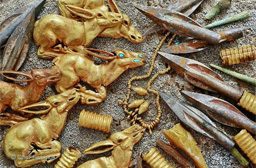ASTANA (Astana Times) – A priceless treasury trove that dates back nearly 800 years before Christ has been uncovered by archaeologists in the remote Tarbagatai Mountains in north-eastern Kazakhstan.

- Some 3,000 golden and precious items were unearthed by archaeologists in a burial mound in the remote Tarbagatai mountains.
(Photo: Oleg Belyalov/east2west news)
Archaeologists found 3,000 gold and precious metals objects and jewellery pieces that are believed to belong to a noble family of the Saka people who ruled throughout central Asia 2,800 years ago. The burial items include bell-shaped earrings, gold plates, chains and necklaces with precious stones. According to the researchers the jewellery was made using sophisticated techniques, indicating a high level of metal working skills for the period.
The Saka, a nomadic Iranian people, were related to the Scythians and dominated the steppes in present-day Kazakhstan and southern Siberia during the first millennium BC.
“’A large number of valuable finds in this burial mound let us believe a man and a woman are buried here — the reigning persons or people who belonged to the elite of Saka society,” said Professor Zainolla Samashev, who is in charge of the project.
Archaeologists continue to excavate the region and say that this could be just the start of more “priceless” discoveries. According to the research, there are around 200 burial mounds on the Eleke Sazy plateau where these treasures were found, but many sites were uncovered and items removed during the rule of Russia’s Peter the Great.
Meanwhile, archaeologists have begun excavating a Saka burial mound found 10 km from Astana, in the course of their work discovering seven other graves dating to the much more recent past (to the 15th and 16th centuries), two of which held women’s jewellery.
The burial mound is 4 in height and 60 m in diameter. The mound is covered with a stone shell. Granite slabs for burial are known to have been taken from the banks of Nura River. According to another hypothesis, Saka tribes could live on the territory of the modern day capital. The excavation will continue to search for evidence.
“Peoples who lived here, in Saryarka, were riders and mounted soldiers. They guarded the territory and this was their main wealth and dignity. It is also known that local peoples took part even in the battle against Cyrus II. This is written in all textbooks”, Maral Khabdulina, Akishev Research Institute of Archaeology Director, said.


Анастасия (2 August 2018, 06:23)
There is confusion between the Saka and Scythians. The Hellenic authors wrote from their frame of reference. They were familiar with the characteristics of the Scythians. Unfortunately many modern writers are doing the same.Scythia itself was a fairly small nation. From about 800 to 300 BCE, the Scythia of Greek texts extended east from the Carpathian Mountains in Central Europe - that is east of Rumania, Eastern Ukraine and Poland of today - east from the Carpathians to the Don River. To the south of Scythia was the Sea of Azov and to the north, the start of the forests. In other words the land of Scythia was a relatively small country that consisted of the grasslands of today’s Moldova, Ukraine and Crimea. It was far removed from the eastern Saka lands and people. However, if we read the classical Greek accounts careful, we find it stated that the origins of the Saka are to be found in the east as part of the Central Asian Aryan family and not the west. The Saka were not Scythians, nor any variation thereof.